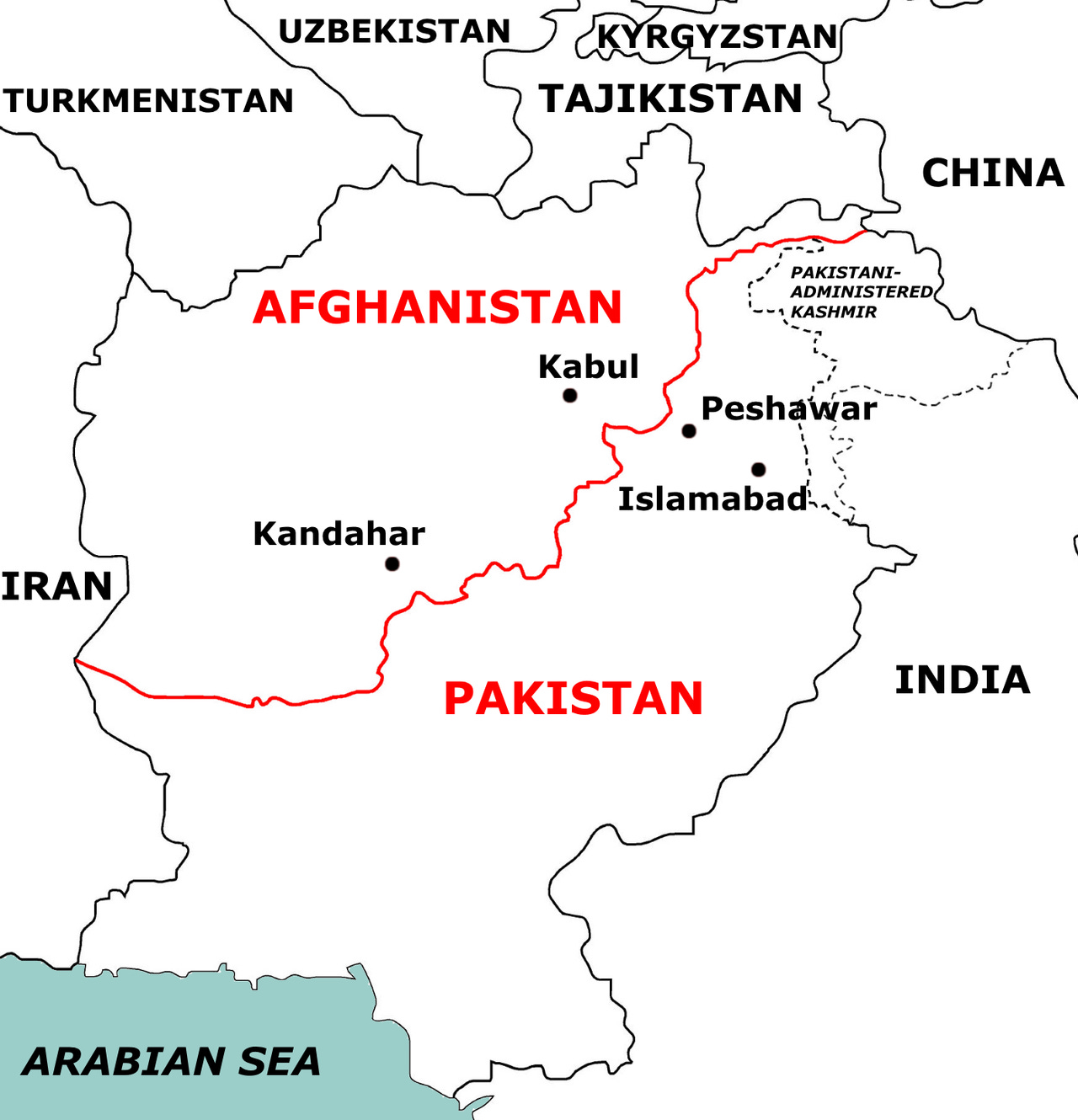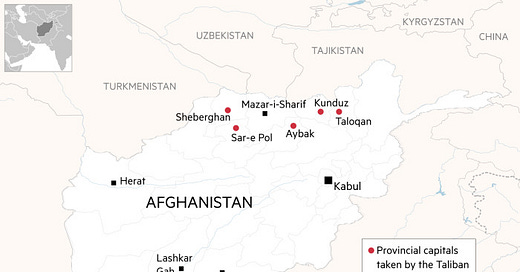The Disaster in Afghanistan
Afghanistan's past remains its present and its future, threatening every major player in the region.
By Vivek Y. Kelkar, Mumbai
The Disaster in Afghanistan
The year was 1842. Britain ruled the waves and the land, an imperial power at its zenith. It sought to control Afghanistan as a buffer against Czarist Russia’s threat to its Indian colonies. On January 6, Major-General Sir William Elphinstone began his retreat from Kabul, with 18,500 men, after a tenuous negotiation with Wazir Akbar Khan, the son of Dost Mohammed, whom the British had ousted from power just three years before.
On January 13, 1842, one man straggled back into the safety of British-controlled Jalalabad, en route to India—William Brydon, the assistant surgeon of Shah Shuja’s Contingent, a British-commanded infantry force recruited in India to provide protection for the East India Company’s puppet ruler in Kabul. When asked where the army was, he famously replied, “I am the army.” The British had been annihilated, by treachery and the local opposition, all along the route back to India. The British returned to Kabul in the fall to avenge their forces’ destruction, but from then on, their control of Afghanistan was precarious. The First Anglo-Afghan War is known to the British as the Disaster in Afghanistan.
On May 6, 1919, the Afghan king Amanullah Khan invaded India, and the Third Anglo-Afghan War began. It ended with an armistice in August 1919. Soon after, a Britain exhausted by the First World War—and in no mood to fight in the plains and mountains of Asia—granted Afghanistan complete independence.
This story bears retelling. The lesson requires reiteration.
The past as the future
For most of the 20th century, at least until 1978, Afghan religious and tribal rivalries caused, at best, small ripples on global power politics. It wasn’t just the Soviet invasion that transformed Afghanistan into a boiling cauldron that threatened mighty powers across the globe. Just as critical was the US strategy of countering the Soviet Union with jihad, a strategy designed to arouse Afghan resistance and nationalism. This set up the dominos that led, first, to the rise of the Taliban, then to a war that that spanned the first two decades of the 21st Century.
The net results? Two decades after the United States went into the country to avenge a dastardly terrorist attack by al Qaeda, sheltering in Afghanistan under the aegis of the Taliban, US forces are leaving. The Taliban is undefeated. America’s revenge remains unfinished. Eight years after the attack, a Navy SEAL team found and killed Osama bin Laden—in Pakistan. Not Afghanistan.
Many would argue, perhaps correctly, that the United States’ goals in Afghanistan were poorly defined in the first place. But none of that matters now. The Taliban is back, the fall of Kabul is months away if not much sooner. The US and the multinational forces that united after September 11 will be gone by August 31, leaving behind turmoil that’s not apt to be confined to the borders of Afghanistan. It threatens every major player in the region: Pakistan, China, India, Iran, Russia, and beyond, to the Central Asian border states of Uzbekistan, Turkmenistan, and Tajikistan.
Same old, same old
Since the middle of the 18th century, the territory today defined as Afghanistan has been ruled from Kabul, and for the largest part of this period, it has been politically dominated by its Pashtun majority tribes. Beyond Kabul, not much has changed, socially, over the centuries. Affinities remain tribal. Constitutional law, in the Western sense, remains little understood, or desired. Historically, the Pashtuns have dominated the south and the east of the country, the areas contiguous with Pakistan and China’s Xinjiang province. The Tajiks, the Hazaras and the Uzbeks have been powerful in the northern and north-central areas that share a border with Tajikistan, Uzbekistan, and Iran. The Hazaras and many Tajiks are Shia; the Pashtuns, Sunni.
“The nation of Afghanistan,” according to its 2004 constitution, which was promulgated with international support following the Taliban’s retreat from Kabul, “shall be comprised of Pashtun, Tajik, Hazara, Uzbek, Turkman, Baluch, Pachaie, Nuristani, Aymaq, Arab, Qirghiz, Qizilbash, Gujur, Brahwui and other tribes.” But in the Afghan context, the word “nation” has always been a misnomer.
It’s not that previous rulers of Afghanistan never tried it. Way back in 1923, King Amanullah Khan endeavored to impose upon the land a Western-inspired constitution. Subsequent rulers—all the way to President Daud Khan, who seized power in 1973 from his cousin King Zahir Khan—have tried to bring the tribes firmly under the rule of Kabul by force, under a unified law. With Soviet support, Daud Khan built a large standing army, complete with tanks and jets, in an effort to bring the tribes under central control. But the government in Kabul remained unable to exercise a firm grip; even the majority Pashtun tribes, from which the Afghan rulers hailed, contested it constantly. Local traditions stubbornly prevailed. Secular schools, modern tax codes, modern legal institutions, social freedoms, and unveiled women stayed confined to Kabul and its environs; the era was marked by sporadic—and bloody—resistance to Daud Khan’s modernizing efforts.
The Soviets, predictably, fared no better. Between 1978 and 1989, its puppet regimes likewise sought to interfere with tribal customs and religious practices to establish central control. The resistance only grew stronger. The US took advantage, capitalizing upon these tribal differences to oust the Soviets. In the process, they created strong, well-armed warlords. They paid them in cash to build nuclei of resistance. Jihad was central to the United States’ strategy. The fundamental premise was that tribal beliefs, loyalties, and behaviors would coalesce, and differences would be set aside—at least, momentarily—under the flag of Islam, through jihad. The strategy worked. The Soviets retreated, and two years later the USSR collapsed under the weight of its own contradictions.
Unsurprisingly, the period between the Soviet withdrawal in 1989 and the Taliban’s final ascendance in Kabul in 1996 saw a bloody internecine war. The US-led resistance to the Soviet Union wasn’t intended, originally, to be a Wahhabi-style jihad. But as events unfolded in Pakistan under the Zia-ul Haq regime, the Taliban was born in the madrassas of Pakistan. Firmly in the Wahhabi tradition, it soon sought power. Initially, many Afghans welcomed the Taliban for the stability they imagined it might bring. But over the years the Talibs, with their dogged adherence to Wahhabi customs, alienated those who remained loyal to local traditions and clans. Clashes intensified.
When the US and the multinational forces went in, after 9/11, the situation was no different. To counter the Taliban, the US and multinational forces wooed the local warlords from the Northern Alliance who had successfully resisted the Taliban. The US brought back the same old tactics: cash payments and arms to warlords. It worked, for a while.
The past remains the present and the future in Afghanistan. Again, a government dominated by Pashtuns and charged with corruption, seeking to rule Afghanistan from Kabul by means of a constitution, could not hold. The US and multinational forces could not stay forever. President Obama’s drawdown of troops from 2011 saw the Taliban make rapid military gains, once again operating from their bases in Pakistan.
The tense future
By Monday, August 9, the Taliban had swept across northern Afghanistan, capturing five northern provincial capitals, including the strategic prize of Kunduz, gateway to the country’s mineral-rich northern provinces and to Central Asia. This was the stronghold of the Northern Alliance that had so ably resisted the Taliban in the late 1990s, under the command of the Uzbek warlord Abdul Rashid Dostum. In a show of strength, the Taliban promptly published videos of the loot they had stolen from Dostum’s home in the newly-recaptured Jawzjan province. Tactically, the Taliban has chosen first to conquer the regions that most resisted it during its previous rule—and it has made sure its successes are well-publicized,
Elsewhere, the Taliban has taken major cities like Ghazni and promptly instituted its harsh version of the Sharia. Of Afghanistan’s 34 provincial capitals, nearly half have fallen to the Taliban. All the others are under siege. In most cases, the central government’s troops have either run away or joined the Taliban.
The US, which planned to leave just 650 troops to guard its embassy in Kabul when it departed on August 31, is back to bombing Taliban targets with B-52 bombers and Specter gunships, flying in from an airbase in Qatar. The Taliban has laid siege to Kandahar and Herat, Afghanistan’s second and third largest cities, and sent bombs and rockets hurtling toward Kabul. Coordinating with the Afghan air force, such as it is, the US is trying to push the Taliban back from these cities via air power. There have been predictable reports of civilian casualties.
In Badakhshan, Takhar, and Ghazni, the Taliban have issued fatwas banning the movement of women without a burqa, diktats to the effect that girls above the age of 12 and widows may be taken by Taliban fighters. A fresh influx of foreign soldiers with allegiance to banned organizations such as al Qaeda, Lashkar-e-Taiba, Jaish-e-Mohammed, the East Turkestan Islamic Movement (ETIM), and the Islamic Movement of Uzbekistan (IMU) have begun operating under the Taliban umbrella. The ETIM and IMU have been critical to the Taliban’s strategy of capturing territories once under the control of the Northern Alliance. Shia Hazaras from north-central Afghanistan have begun fleeing the Sunni Taliban’s persecution. Thousands of refugees have already arrived as far away as Greece.
Yet the Taliban may not find it so easy to move forward, despite their relatively quick gains against central government forces. A relatively new Shia organization, sponsored by Iran, has its own proxy militia in Afghanistan. The Fatemiyoun Brigade is largely composed of Iranian veterans from the conflict in Syria, Afghan Shias who sought refuge in Iran, and other Shia tribes such as the Hazaras. In 2019, the US designated the Syrian Fatemiyoun a terrorist organization. This estimated 30,000-strong brigade is now actively resisting Taliban forces in areas adjacent to Iran.
Older warlords, including the septuagenarian veteran of the anti-Soviet resistance Gulbuddin Hekmatyar, the former Balkh Province Governor Mohammed Atta Noor, Abdul Rashid Dostum, Mohammed Ismail Khan, and others have begun seeking arms and funds to resist the Taliban advance. Though momentarily beaten, men like Dostum, Noor and Ismail Khan are known survivors. They may retreat, but they are apt to live to fight another day. Within Afghanistan, the specter of another long and bloody civil war looms again. Its spillover threatens many in the region.
The immediate neighbors—Pakistan, China, Tajikistan, Uzbekistan, and Russia— would seem to have placed their bets on the Taliban. But the Taliban can scarcely be assured of real support from any of these countries, given their ability to destabilize all of these regimes using hardcore religion as propaganda.
The Neighbor’s Conundrum

Pakistan, facing repeated accusations of financing and supplying the Taliban, has tried to walk a tightrope. Islamabad denies lending them support. But Pakistan’s army remains intimately tied to the Taliban’s success. To certain generals in Islamabad, control over Afghanistan affords Pakistan a welcome strategic depth. Others in Pakistan’s army—and civilian authorities—are not so sure. Internal reports from Islamabad indicate that some generals are now wary of offering covert support to the Taliban, fearing a major refugee influx into Pakistan’s north and homegrown terror from hardline religious groups.
Pakistan’s border with Afghanistan is porous and contentious. Neither country has ever successfully demarcated or protected the Durand Line between them. In Pakistan’s Khyber Pakhtunkhwa province, abutting Afghanistan, the Pashtuns have never accepted the line as a formal border. Throughout history, people and goods have flowed over it freely. Political parties in the region such as the Pashtun Tahafuz Movement are already up in arms against Islamabad’s efforts to block refugees from pouring across from Afghanistan. Other extremist organizations, like the Tehreek-i-Taliban Pakistan (TTP)—long accused of brutal terrorism within Pakistan—have actively sought and built bases in the Khyber Pakhtunkhwa region.
The Pakistani media is full of reports of clerics across the country asking for donations for the Afghan Taliban at mosques and other religious forums, though the government claims the reports are false. Also widely reported are stories of fundamentalist youth joining Taliban fighters. So are stories and videos of the burials of shahids, or martyrs, from Afghanistan.
For Imran Khan’s government, all of this spells trouble. The international Financial Action Task Force (FATF) has Pakistan on its grey list—one step away from its blacklist, which would turn Pakistan into a global financial pariah, unable to access loans and funds from multilateral or other governmental financial organizations. In its June 2021 report, the FATF commended Pakistan for several accomplishments in compliance, but noted,
The FATF encourages Pakistan to continue to make progress to address as soon as possible on the one remaining [Combating the Financing of Terrorism]-related item by demonstrating that investigations and prosecutions target senior leaders and commanders of UN designated terrorist groups.
These groups include the TTP, Lashkar-e-Taiba and others long accused by neighboring India and the Afghanistan government in Kabul of fomenting terrorism and religious obscurantism.
Tomorrow, in Part 2, we consider the fallout for Iran, Central Asia, Russia, China, and the Afghan economy.







Once again, Clausewitz has been vindicated. He wrote that the first, most fundamental task of a statesman contemplating war is to decide what kind of war it will be; that is, to frame a definition of victory. For war is an instrument of policy, and the policy objective is the definition of victory.
What, though, was the US policy objective in Afghanistan? What, where, was the point at which the soldiers could look around and say, “Mission accomplished”? Nobody knew, not really, and so on the US side the war was a succession of expedients. The Taliban, however, knew exactly what its objective was and how to achieve it: by a strategy of what might be called psychological attrition. The enemy thought he could exhaust the patience and commitment of the US, and since the US didn’t really know what it was doing, the enemy was successful.
Really very informative. Vivek Kelkar’s article reminded me of an essay written by Adam Garfinkle in the American Interest over a decade ago. Obama was President at the time and Adam suggested that it would be difficult to solve the problems of Afghanistan and Iran simultaneously. Given resource constraints and limited amounts of public enthusiasm for foreign policy adventurism, Adam thought it might be an either/or situation. The essay is well worth a read,
https://www.the-american-interest.com/2010/03/01/spring-note-disconnected/
Of course, here we are a decade later and the situation with Iran and Afghanistan are both getting worse.
It’s just one more example of the bumbling incompetence of bipartisan American foreign policy “experts.” They never get anything right. Like the keystone cops they stumble from disaster to disaster.
Say what you want about Trump, but at least he recognized that the clowns leading American foreign policy since at least the end of the Cold War, were weakening the United States not strengthening it.
What exactly is to be gained now by sending in the B52 bombers? It’s little more than a feckless act that makes the United States look even more pathetic than it already does.
Trump was right when he said during his campaign against Hillary Clinton that our country “never wins anymore.” Can anyone really deny that? Isn’t it time to acknowledge that both the foreign policy Mandarins and military leaders (all globalists by the way) who have been designing and implementing policy for decades have done a horrendous job?
The Biden foreign policy team, the Obama foreign policy team and the Bush (the second) foreign policy team all had one thing in common. They were populated by morons who never seem to get anything right.
Does anyone remember when Trump ordered the attack that killed Qasem Soleimani? He was widely (and often vitriolically) criticized for it by both the Democratic and Republican foreign policy establishments.
Yet more was gained by killing this one man than the United States accomplished in the long years we spent wasting our time and resources in Afghanistan.
How many American soldiers came home from Afghanistan without arms and legs because of the stupidity if not venality of our bipartisan cabal of experts?